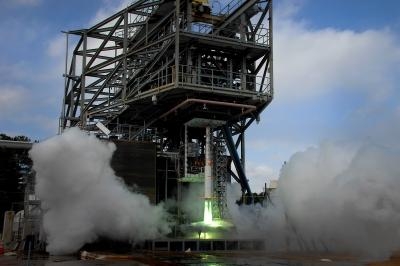Studying How Sound From Boosters Will Affect Rocket And Crew During Liftoff
The first round of acoustic tests on a scale model of NASA's Space Launch System (SLS) is underway. The tests will allow engineers to verify the design of the sound suppression system being developed for the agency's new deep space rocket. The testing, which began Jan. 16 at NASA's Marshall Space Flight Center in Huntsville, AL, will focus on how low- and high-frequency sound waves affect the rocket on the launch pad. This testing will provide critical data about how the powerful noise generated by the engines and boosters may affect the rocket and crew, especially during liftoff.

"We can verify the launch environments the SLS vehicle was designed around and determine the effectiveness of the sound suppression systems," said Doug Counter, technical lead for the acoustic testing. "Scale model testing on the space shuttle was very comparable to what actually happened to the vehicle at liftoff. That's why we do the scale test."
During the tests, a 5-percent scale model of the SLS is ignited for five seconds at a time while microphones, located on the vehicle and similarly scaled mobile launcher, tower and exhaust duct, collect acoustic data. A thrust plate, side restraints and cables keep the model secure.
Engineers are running many of the evaluations with a system known as rainbirds, huge water nozzles on the mobile launcher at NASA's Kennedy Space Center in Florida. During launch, 450,000 gallons of water will be released from five rainbirds just seconds before booster ignition. Water is the main component of the sound suppression system because it helps protect the launch vehicle and its payload from damage caused by acoustical energy.

A series of acoustics tests also is taking place at the University of Texas at Austin. Engineers are evaluating the strong sounds and vibrations that occur during the ignition process for the RS-25 engines that will power SLS. First to be tested is the rocket's core stage, which houses many of the launch vehicle's critical pieces including the flight computer and avionics. The test of the fully assembled vehicle, which will include the solid rocket motors, will be conducted later this year.
The SLS core stage model has four liquid oxygen-hydrogen thrusters that simulate the four RS-25 engines built by Aerojet Rocketdyne of Canoga Park, Calif. Two Alliant Techsystems Inc. (ATK) Rocket Assisted Take-Off (RATO) motors represent the five-segment solid rocket motors on SLS. ATK, based in Promontory, Utah, is building the boosters. The motors burn similarly to how a solid motor would burn for the initial SLS vehicle configuration.
The first flight test of the SLS in 2017 will be configured for a 77-ton lift capacity and carry an uncrewed Orion spacecraft beyond low-Earth orbit to test the performance of the integrated system. As the SLS is evolved, it will the most powerful rocket ever built and provide an unprecedented lift capability of 143 tons to enable missions even farther into our solar system.
(Images provided by NASA)
 ANN's Daily Aero-Term (04.25.24): Airport Rotating Beacon
ANN's Daily Aero-Term (04.25.24): Airport Rotating Beacon ANN's Daily Aero-Linx (04.25.24)
ANN's Daily Aero-Linx (04.25.24) Klyde Morris (04.22.24)
Klyde Morris (04.22.24) Airborne 04.24.24: INTEGRAL E, Elixir USA, M700 RVSM
Airborne 04.24.24: INTEGRAL E, Elixir USA, M700 RVSM Airborne 04.22.24: Rotor X Worsens, Airport Fees 4 FNB?, USMC Drone Pilot
Airborne 04.22.24: Rotor X Worsens, Airport Fees 4 FNB?, USMC Drone Pilot




